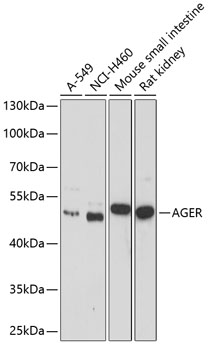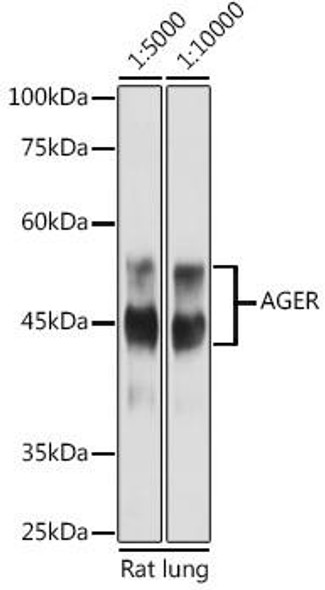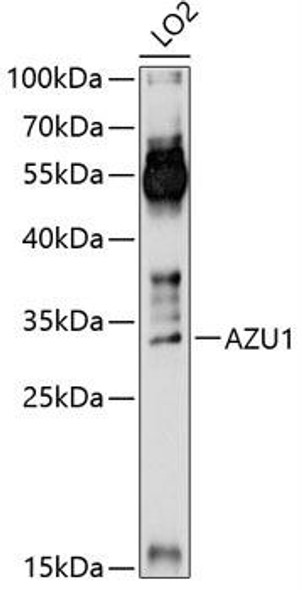Immunology Antibodies 1
Anti-AGER Antibody (CAB1395)
- SKU:
- CAB1395
- Product Type:
- Antibody
- Reactivity:
- Human
- Reactivity:
- Mouse
- Reactivity:
- Rat
- Host Species:
- Rabbit
- Isotype:
- IgG
- Antibody Type:
- Polyclonal Antibody
- Research Area:
- Immunology
Description
| Antibody Name: | Anti-AGER Antibody |
| Antibody SKU: | CAB1395 |
| Antibody Size: | 20uL, 50uL, 100uL |
| Application: | WB |
| Reactivity: | Human, Mouse, Rat |
| Host Species: | Rabbit |
| Immunogen: | Recombinant fusion protein containing a sequence corresponding to amino acids 30-330 of human AGER (NP_001127.1). |
| Application: | WB |
| Recommended Dilution: | WB 1:500 - 1:2000 |
| Reactivity: | Human, Mouse, Rat |
| Positive Samples: | A-549, NCI-H460, Mouse small intestine, Rat kidney |
| Immunogen: | Recombinant fusion protein containing a sequence corresponding to amino acids 30-330 of human AGER (NP_001127.1). |
| Purification Method: | Affinity purification |
| Storage Buffer: | Store at -20'C. Avoid freeze / thaw cycles. Buffer: PBS with 0.02% sodium azide, 50% glycerol, pH7.3. |
| Isotype: | IgG |
| Sequence: | IGEP LVLK CKGA PKKP PQRL EWKL NTGR TEAW KVLS PQGG GPWD SVAR VLPN GSLF LPAV GIQD EGIF RCQA MNRN GKET KSNY RVRV YQIP GKPE IVDS ASEL TAGV PNKV GTCV SEGS YPAG TLSW HLDG KPLV PNEK GVSV KEQT RRHP ETGL FTLQ SELM VTPA RGGD PRPT FSCS FSPG LPRH RALR TAPI QPRV WEPV PLEE VQLV VEPE GGAV APGG TVTL TCEV PAQP SPQI HWMK DGVP LPLP PSPV LILP EIGP QDQG TYSC VATH SSHG PQES RAVS ISII EPGE EGPT A |
| Gene ID: | 177 |
| Uniprot: | Q15109 |
| Cellular Location: | Cell membrane, Secreted, Single-pass type I membrane protein |
| Calculated MW: | 13kDa/35-44kDa |
| Observed MW: | 43kDa |
| Synonyms: | AGER, RAGE, SCARJ1 |
| Background: | The advanced glycosylation end product (AGE) receptor encoded by this gene is a member of the immunoglobulin superfamily of cell surface receptors. It is a multiligand receptor, and besides AGE, interacts with other molecules implicated in homeostasis, development, and inflammation, and certain diseases, such as diabetes and Alzheimer's disease. Many alternatively spliced transcript variants encoding different isoforms, as well as non-protein-coding variants, have been described for this gene (PMID:18089847). |
| UniProt Protein Function: | RAGE: Mediates interactions of advanced glycosylation end products (AGE). These are nonenzymatically glycosylated proteins which accumulate in vascular tissue in aging and at an accelerated rate in diabetes. Acts as a mediator of both acute and chronic vascular inflammation in conditions such as atherosclerosis and in particular as a complication of diabetes. AGE/RAGE signaling plays an important role in regulating the production/expression of TNF- alpha, oxidative stress, and endothelial dysfunction in type 2 diabetes. Interaction with S100A12 on endothelium, mononuclear phagocytes, and lymphocytes triggers cellular activation, with generation of key proinflammatory mediators. Interaction with S100B after myocardial infarction may play a role in myocyte apoptosis by activating ERK1/2 and p53/TP53 signaling. Receptor for amyloid beta peptide. Contributes to the translocation of amyloid-beta peptide (ABPP) across the cell membrane from the extracellular to the intracellular space in cortical neurons. ABPP-initiated RAGE signaling, especially stimulation of p38 mitogen-activated protein kinase (MAPK), has the capacity to drive a transport system delivering ABPP as a complex with RAGE to the intraneuronal space. Interacts with S100B, S100A1 and APP. Interacts with S100A12. Endothelial cells. 4 isoforms of the human protein are produced by alternative splicing. |
| UniProt Protein Details: | Protein type:Membrane protein, integral; Motility/polarity/chemotaxis; Receptor, misc.; Cell cycle regulation Chromosomal Location of Human Ortholog: 6p21.3 Cellular Component: integral to plasma membrane; extracellular region; plasma membrane Molecular Function:identical protein binding; protein binding; transmembrane receptor activity; receptor activity Biological Process: cell surface receptor linked signal transduction; response to wounding; innate immune response; inflammatory response; neurite development; induction of positive chemotaxis; activation of NF-kappaB transcription factor |
| NCBI Summary: | The advanced glycosylation end product (AGE) receptor encoded by this gene is a member of the immunoglobulin superfamily of cell surface receptors. It is a multiligand receptor, and besides AGE, interacts with other molecules implicated in homeostasis, development, and inflammation, and certain diseases, such as diabetes and Alzheimer's disease. Many alternatively spliced transcript variants encoding different isoforms, as well as non-protein-coding variants, have been described for this gene (PMID:18089847). [provided by RefSeq, May 2011] |
| UniProt Code: | Q15109 |
| NCBI GenInfo Identifier: | 2497317 |
| NCBI Gene ID: | 177 |
| NCBI Accession: | Q15109.1 |
| UniProt Secondary Accession: | Q15109,Q15279, Q3L1R4, Q3L1R5, Q3L1R6, Q3L1R7, Q3L1R8 Q3L1S0, A2BFI7, A6NKF0, A7Y2U9, B0V176, |
| UniProt Related Accession: | Q15109 |
| Molecular Weight: | 41,098 Da |
| NCBI Full Name: | Advanced glycosylation end product-specific receptor |
| NCBI Synonym Full Names: | advanced glycosylation end product-specific receptor |
| NCBI Official Symbol: | AGER |
| NCBI Official Synonym Symbols: | RAGE |
| NCBI Protein Information: | advanced glycosylation end product-specific receptor; RAGE isoform sRAGE-delta; RAGE isoform NtRAGE-delta; receptor for advanced glycation end-products variant 20 |
| UniProt Protein Name: | Advanced glycosylation end product-specific receptor |
| UniProt Synonym Protein Names: | Receptor for advanced glycosylation end products |
| Protein Family: | Advanced glycosylation end product-specific receptor |
| UniProt Gene Name: | AGER |
| UniProt Entry Name: | RAGE_HUMAN |
View AllClose







